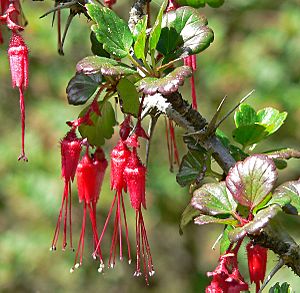Ribes speciosum facts for kids
Quick facts for kids Fuchsia-flowered gooseberry |
|
|---|---|
 |
|
| Scientific classification | |
| Genus: |
Ribes
|
| Species: |
speciosum
|
| Synonyms | |
|
|
The Ribes speciosum is a cool plant often called the fuchsia-flowered gooseberry or Californian fuchsia. It's part of the Grossulariaceae family, which also includes yummy currants and other gooseberries. This plant is a deciduous shrub, meaning it loses its leaves in the fall. It has spiny stems and amazing red flowers that bloom in spring. These flowers look a lot like fuchsias, but they aren't actually related!
This special plant grows naturally in central and southern California and also in Baja California, Mexico. You can find it in the scrublands and chaparral areas of the coastal mountains.
Contents
What Does the Fuchsia-Flowered Gooseberry Look Like?
The fuchsia-flowered gooseberry is a spreading shrub that can grow quite tall, up to about 10 feet (3 meters). Its stems are covered in tiny bristles, and each stem joint has three long spines. The leaves are tough and feel a bit like leather. They have a few shallow lobes and are mostly smooth, with a dark green and shiny top surface.
Its Unique Flowers
The flowers of this plant are truly eye-catching! They can grow alone or in small groups of up to four flowers. Each flower forms a tube made of bright scarlet sepals, which are like the outer leaves of a flower. These sepals are covered in tiny glands. Inside, there are four red petals. The most striking part is how long the red stamens (which hold pollen) and stigmas (which receive pollen) stick out from the flower's opening. They can be as long as 1.6 inches (4 centimeters)!
Fruity Berries
After the flowers, the plant produces small, red-orange berries. Each berry is about 0.4 inches (1 centimeter) long and is covered in lots of tiny, sticky bristles.
Growing Fuchsia-Flowered Gooseberry in Gardens
People love to grow Ribes speciosum in their gardens because it's a beautiful ornamental plant. It's especially popular in drought-tolerant gardens, which means it doesn't need much water. It's also great for native plant gardens and wildlife gardens because it helps local animals.
This plant likes places with some shade or bright light, but not direct, harsh sun all day. It grows well in dry gardens and under oak trees. Because it's such a great garden plant, it has even won an award called the Royal Horticultural Society's Award of Garden Merit!

